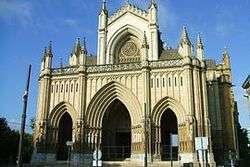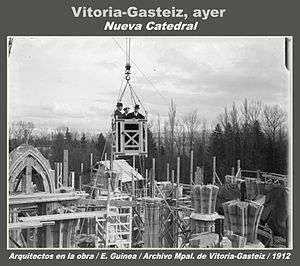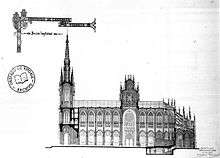Cathedral of María Inmaculada of Vitoria
| Cathedral of María Inmaculada of Vitoria | |
|---|---|
|
Native names Spanish: Catedral de María Inmaculada de Vitoria Basque: Maria Sortzez Garbiaren katedrala | |
 | |
| Location | Vitoria-Gasteiz, Spain |
| Coordinates | 42°50′43″N 2°40′39″W / 42.845403°N 2.677563°WCoordinates: 42°50′43″N 2°40′39″W / 42.845403°N 2.677563°W |
| Area | Lovaina |
| Built | 1907-1914, 1946-1969 |
| Architect |
Julián de Apraiz and Javier de Luque (first period) Miguel de Apraiz Barreiro and Antonio Camuñas Paredes (second period) |
| Official name: Maria Sortzez Garbiaren Katedrala (eu) / Catedral de María Inmaculada de Vitoria (es) | |
| Type | Non-movable |
| Criteria | Monument |
 Location of Cathedral of María Inmaculada of Vitoria in Spain | |
The Cathedral of María Inmaculada de Vitoria (Basque: Maria Sortzez Garbiaren katedrala, Spanish: Catedral de María Inmaculada de Vitoria, usually known as "The new Cathedral" (Basque: Katedral Berria, Spanish: Catedral Nueva) is a Neogothic-style, Roman Catholic cathedral located in Vitoria-Gasteiz, Basque country, Spain. It was built in the first half of the XX century.
History
First constructive period (1907-1914)

In the site that was occupied by Convent of the Brígidas, just near of the Florida Park, works started on August 4 of 1907 based on the plans by architects Julián Apraiz [1] and Javier de Luque and with the help of José Cadena y Eleta, bishop of Vitoria by then.
Second constructive period (1946-1969)

The popularly named "ruins" of the Cathedral were covered by ivy and weeds. Works were not restarted until 1946, once the Spanish Civil War was ended. They were economically helped by the bishop Carmelo Ballester Nieto and directed by the architect Miguel de Apraiz Barreiro, Julian's son.
Construction proceeded slowly, respecting the initial style but incorporating the new techniques of concrete and artificial stone. In 1949 the ambulatory and lower cruise were ended. Until 1952 tall ship of the presbytery, the north side portal and a tower lowered instead of the original dome were built. Between 1960 and 1963 the windows made in the first period were placed, and the ambulatory reliefs by the artist es:Enrique Monjo. Between 1964 and 1969 the rest of the cathedral was covered without adding external buttresses unnecessary weights to lighten and strengthen the factory using new materials mentioned above
Although unfinished, the temple was consecrated on September 24 of 1969 by the legacy Cardinal Dell'Acqua, accompanied by several archbishops and Spanish bishops, and in the presence of the head of state, General Francisco Franco, his wife and the Government almost full.
This work was completed in 1973, being head of the diocese Bishop Francisco Peralta, thanks to the confluence of financial allocations from the Provincial Council of Alava, the Ministry of Housing and numerous and some private donations.
Description
The building, of imposing proportions, has 5 longitudinal naves, main and four side, a cruise of three naves, an apse aisle with two naves with seven apsidal chapels, a porch, a crypt and a sacristy. With 118 meters apse portico, its 62 meters wide between the two end walls of the transept and 35 meters high on the cruise, is the second largest church in Spain after the Cathedral of Seville. Its Latin cross is reminiscent of the Chartres Cathedral and covers an area of 5,750 square meters and can shelter inside 150,000 people.